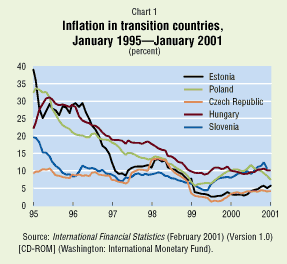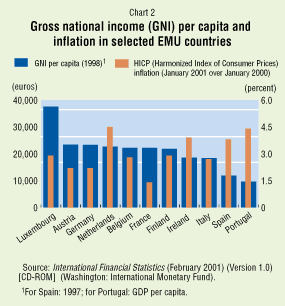 About F&D Subscribe Back Issues Write Us Copyright Information |
Transition Countries' Choice of Exchange Rate Regime in the Run-Up to EMU Membership György Szapáry An important decision for the Central and Eastern European countries seeking membership in the European Union is choosing the most appropriate exchange rate regime. Experience has shown that many considerations are involved in this decision and that there is no "one-size-fits-all" solution. The creation of European Economic and Monetary Union (EMU) opened a new chapter in the debate over countries' choice of exchange rate regime. At stake is selection of the regime that will best serve the interests of the Central and Eastern European countries preparing to join the European Union (EU) and seeking to meet the criteria embodied in the Maastricht Treaty, which will allow them to enter EMU later. These accession countries, with their small, open economies, have a strong interest in joining the euro zone, which will offer them a number of economic advantages, including lower risk premiums, interest rates, and transaction costs. The question is whether there is an ideal exchange rate regime for transition countries during the run-up to EMU that can ensure stability, maintain competitiveness, promote structural reforms, and also help them meet the Maastricht criterion for inflation.
The accession countries maintain a wide diversity of exchange rate regimes, from a currency board arrangement (Estonia) to floating regimes (Poland since April 2000 and the Czech Republic). Hungary's system, a preannounced crawling peg with a relatively narrow band of 2.25 percent on either side, in effect until early May 2001, fell between these two extremes. (Effective May 4, Hungary widened the fluctuation band to ±15 percent while maintaining the crawling peg.) A common goal of the countries is to move toward meeting the Maastricht criteria as they complete their transitions, but there seems to be no direct link between the exchange rate regime they have in place and their progress in meeting that goal. For instance, Estonia has come close to achieving the EU inflation level with its currency board, as has the Czech Republic with its floating regime. Poland has followed approximately the same path of disinflation with a wide-band crawling peg, and Hungary with a narrow-band crawling peg (Chart 1). Although these results are testimony to the fact that other policies matter as much as the exchange rate regime, the choice of exchange rate regime remains an issue because the countries' ultimate goal is to fix their currencies to the euro in an orderly and efficient way.

Common characteristics The acceding transition countries share a number of characteristics that have a bearing on exchange rate policy. First, their wages and prices of nontradables are lower than those of the EU countries and, in line with the so-called Balassa-Samuelson effect (see box), will rise faster than the prices in the latter as the transition economies catch up with the European Union. Hence, the real exchange rates of the accession countries, as measured by the consumer price index, will appreciate during the catching-up process, which is likely to take several years. If these countries are to avoid a loss of competitiveness and serious balance of payments problems, the real appreciation must be broadly in line with the underlying Balassa-Samuelson effect. Second, these highly open economies are integrated into a global financial system in which the flow of capital is much less restricted than it was, for example, when Greece, Portugal, and Spain joined the European Union. Because of their status as emerging markets, the accession countries remain exposed to volatile capital flows, as witnessed during the Russian financial crisis of 1998 when capital fled these countries, irrespective of the state of their fundamentals or exchange rate regimes. Third, the accession countries face relative price adjustments beyond the Balassa-Samuelson effect because of their ongoing structural reforms and liberalization in such areas as telecommunications, energy, transportation, and health care. The inflationary impact of these changes is less stable and progressive than that of the Balassa-Samuelson effect because it is linked to the timing of reforms, which, in turn, is often linked to the privatization of those activities. Fourth, these countries have small domestic markets and rely heavily on exports and imports for investment and growth. A loss of competitiveness would translate fairly rapidly into a deterioration of the balance of payments. When selecting an exchange rate regime, the authorities of the accession countries are confronted with three conflicting objectives: (1) ensuring reasonable exchange rate stability in the face of capital volatility, (2) securing an orderly real exchange rate appreciation more or less along the path dictated by the Balassa-Samuelson effect, and (3) taking steps toward meeting the Maastricht inflation criterion. That criterion stipulates that one year before joining EMU, the accession country's rate of inflation should not exceed by more than 1.5 percentage points the average rate of inflation in the three EU countries where inflation is the lowest. The stability objective would be best served by a fixed-rate regime. However, because of the risk that the wage flexibility and strong supportive policies required to sustain a fixed rate cannot be implemented, a rigidly fixed rate could lead to a rapid appreciation of the real exchange rate, which could prove untenable. A flexible exchange rate arrangement, in the form of a wide band or a free float, could, in principle, make possible a gradual appreciation of the real exchange rate in conformity with the Balassa-Samuelson effect and also help the country meet the inflation target without relying on unduly restrictive monetary and fiscal policies. However, because transition countries are particularly exposed to the volatility of speculative capital flows, flexible regimes may lead to large real exchange rate variability. One argument often made in favor of flexible regimes is that they offer better protection against speculative attacks. During the Russian crisis, however, Israel and Poland—both considered emerging markets—discovered that wide bands did not shield them from speculative attacks in the face of a sudden shift in market sentiment. Another argument—that, because of the greater potential risk of depreciation, wide bands discourage speculative capital inflows—is not supported by the experiences of Israel and Poland before the Russian crisis: both countries witnessed large capital inflows (see Darvas and Szapáry, 2000). The convergence play Accession countries are likely to attract capital inflows as investors anticipate the convergence of interest rates and the appreciation of their exchange rates. Indeed, the expectation that these countries will follow policies that will allow them to become members of EMU promises good returns with less risk on speculative capital. To meet the inflation criterion for joining EMU, the monetary authorities of the applicant countries will try to maintain a nominal interest rate that is higher than required by the exchange rate risk, encouraging foreigners to invest in fixed-income instruments denominated in domestic currency, such as government securities. The favorable prospects for growth also attract foreign investment into the stock markets of these countries, as they did in Greece, Portugal, and Spain, whose stock markets outperformed the other European markets following entry into the European Union. The expected return on these types of portfolio investments is enhanced by the anticipated appreciation of the exchange rate. The inflow of speculative capital creates specific problems for the accession countries. First, it is too early for them to be caught up in the convergence play. The date of EMU membership is still uncertain, and an undue appreciation of these countries' currencies or a too rapid fall in domestic interest rates brought about by capital inflows would not be consistent with their stabilization goals. Second, these countries remain vulnerable to shifts in market sentiment triggered by financial crises elsewhere. The more speculative capital enters the country, the more capital will be able to flow out when market perceptions change, undermining stability. Capital flows that are insignificant for markets the size of the United States or the euro zone can disrupt the exchange markets of countries like the Czech Republic, Hungary, and even Poland. The "weighing-in" syndrome The choice of exchange rate regime in the run-up to EMU should take into account the need to meet the Maastricht criterion for inflation, which, as previously noted, is linked to the inflation rate in the European Union. Given that the catching-up process implies a higher rate of inflation through the Balassa-Samuelson effect, the Maastricht inflation criterion can be achieved only through very restrictive monetary and fiscal policies—which may jeopardize growth and employment—or through an appreciation of the nominal exchange rate. Countries are likely to resist an appreciation of the nominal exchange rate that they consider too fast because they fear a loss of competitiveness, particularly as capital flows intensify with the approach of EMU membership. Accession countries are likely to respond with what might be called the "weighing-in" syndrome: like the boxer who refrains from eating for hours prior to the weigh-in only to consume a big meal once it is over, the candidate country will maintain very tight monetary policy and resort to various techniques (for example, freezing administered prices or lowering consumption taxes) to squeeze down inflation prior to accession, only to shift gears after it enters EMU. As a result of this stop-go cycle, the efficiency of economic management will suffer. One way of avoiding the weighing-in syndrome is to take explicit account of the principle of the Balassa-Samuelson effect in the Maastricht criteria by allowing more room for maneuver than is provided by the current rule, which falls short of most estimates of this effect. From a strictly economic point of view, the logical solution would be to link the permissible inflation deviation to the size of the productivity growth differential, because it is that differential that determines the Balassa-Samuelson effect. However, because the growth of productivity is subject to cyclical factors that can differ from one country to the next, it would be difficult to find a standard measurement of the Balassa-Samuelson effect that could be uniformly applied to define the permissible inflation deviation. A better solution would be to group both the member countries and the accession countries according to per capita income and to define the reference value for inflation deviation on that basis. The reference for high-income countries would be the average inflation rate in the highest per capita income group, and the reference for the low-income countries would be the average inflation rate in the lowest per capita income group. Grouping the countries this way is a good proxy for their level of development and, therefore, for the extent of the expected faster productivity growth and the Balassa-Samuelson effect. Indeed, it is not surprising that the EMU member countries with the lowest per capita incomes, Portugal and Spain, have recorded higher-than-average inflation rates within the euro zone (Chart 2). Such a differentiated treatment would, however, violate the principle of equal treatment between the initial EMU members and those that join the monetary union later. Understandably, the principle of equal treatment was upheld when the initial criteria for joining EMU were negotiated and the founding members established the monetary union. It is difficult to imagine how it could have been otherwise; reaching agreement on the different rates of inflation to be assigned to the different countries could have paralyzed the negotiations. Now that the monetary union is established and functioning, a more finely tuned approach that takes into account the laws of economic development would better serve the efficiency of economic management.

Though logical from an economic point of view, differentiating the permissible EMU entry-level inflation rate according to the accession countries' level of economic development also poses some danger. The danger stems from the popular fear in EMU that such "permissiveness" could dilute price stability within the euro zone and weaken the euro. This fear could undermine the political support for enlargement and delay the accession of the countries of Central and Eastern Europe, particularly those with the lowest per capita incomes. A reasonable compromise would be to define the permissible inflation deviation with reference to the average inflation rate of the euro zone (the Harmonized Index of Consumer Prices, HICP) and not to the three EU members with the lowest inflation. When the Maastricht Treaty was negotiated and there were several national monetary policies, the founding members wanted to encourage convergence toward the lowest level of inflation. Now that a single monetary policy is responsible for inflation in the euro zone as a whole, it makes more sense to define the deviation with reference to the average inflation rate in the zone. For a country wishing to join EMU in December 2000, this would have given an additional margin of 1.0 percent (2.3 percent EMU average inflation versus 1.3 percent average inflation in the three EU countries with the lowest inflation). Although small, a difference of this magnitude can still be significant at such low levels of inflation. Another option would be simply to increase the permissible inflation deviation, but this step could be regarded as a watering down of the Maastricht criterion and could raise the same popular fear as mentioned above. No "one-size-fits-all" exchange rate regime While EMU accession for Central and Eastern European transition countries is still several years away, it is close enough to require decisions as to what type of exchange rate regime will best serve their economic development and their transition to EMU membership. As can be seen from the above discussion, the authorities of the accession countries are confronted with complex issues to consider when choosing their exchange rate regimes: the characteristics of their economies, their decision to follow a track leading to membership in the euro zone, and the globalization of financial markets. As a result of the combined impact of globalization and EU convergence, accession countries are likely to continue to attract financial capital flows. They also remain exposed to shifts in market sentiment that can cause a sudden reversal of capital flows not otherwise justified by developments in their economic fundamentals. There is no clear-cut solution. Countries' experiences with different exchange rate regimes convincingly show that no one regime is appropriate for all the accession countries in the run-up to EMU and that many considerations influence countries' decisions. The most obvious is the strength of the political commitment to pursue macroeconomic policies—in particular, fiscal, monetary, and income policies—that will ensure internal and external stability. The looser that commitment, the less likely it is that a rigidly fixed system can survive the pressures of the market. Progress with structural reforms, such as privatization, the lifting of price controls, and health care reforms, also needs to be considered because such reforms affect the future path of inflation. Slower progress in these areas would argue in favor of a more flexible exchange rate regime to accommodate the potential inflationary shocks. The requirement to meet the Maastricht criterion for inflation would argue against a rigidly fixed system because it would not leave room for a nominal appreciation of the currency to help bring down inflation. The burden would then fall entirely on other policies at a cost that may be unjustified. An early unilateral adoption of the euro, advocated by some economists, would have the same disadvantage.
The views expressed in the article are those of the author and do not necessarily reflect the official views of the National Bank of Hungary. Reference:
|